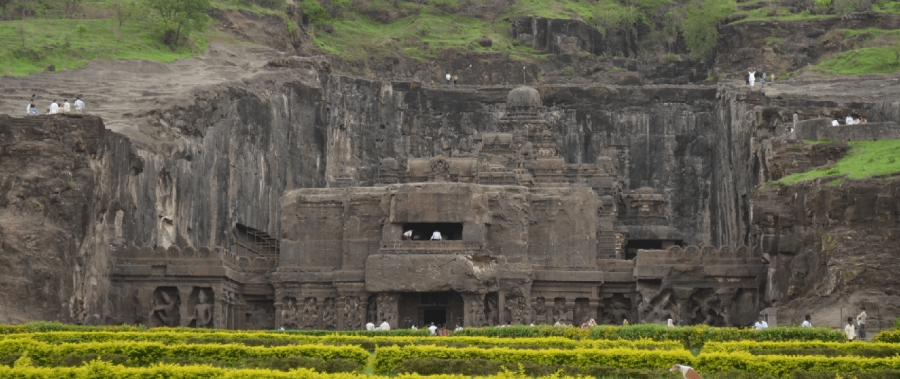GLIMPSE OF AURANGABD Customized Holiday Short Trips
AURANGABAD- AJANTA & ELLORA
Package Highlights
The Ajanta Caves are 30 (approximately) rock-cut Buddhist cave monuments which date from the 2nd century BCE to about 480 CE in Aurangabad district of Maharashtra state of India. The caves include paintings and rock-cut sculptures described as among the finest surviving examples of ancient Indian art, particularly expressive paintings that present emotion through gesture, pose and form.
Ellora is a UNESCO World Heritage Site located in the Aurangabad district of Maharashtra, India. It is one of the largest rock-cut monastery-temple cave complexes in the world, featuring Buddhist, Hindu and Jain monuments, and artwork, dating from the 600–1000 CE period.Cave 16, in particular, features the largest single monolithic rock excavation in the world, the Kailasha temple, a chariot shaped monument dedicated to Shiva.
Highlight of The Trip :
- Bibi Ka Maqbara
- Ajanta Caves
- Aurangabad Caves
- Quila-E-Ark
- Sunehri Maha
Tour Includes
Itinerary
Day 01: Arrival Aurangabad
On arrival, check-in at the hotel. Later, we will visit Ellora and Ajanta Caves, Aurangabad Cave and enjoy an overnight stay at the hotel.
Ellora Cave: Recorded in the list of world-heritage site, Ellora cave is situated around 30 km away from Aurangabad. The Kailash Temple of the Ellora caves is the major attraction among the tourists and work of art of the architect. The temple is one of the largest and massive sculptures of the world.
Aurangabad Cave: Excavated from the soft rock during the 6th and 7th century, the caves are divided into two separate locations – Western Group Caves having caves 1-5 and Eastern Group Caves having caves 6-10, located 1 km from apart. The image and designing is moulded by Tantric Hinduism.
Day 02: Aurangabad (Sightseeing)
After breakfast we will visit Bibi Ka Maqbara, Quila-E-Ark and Sunehari Mahal. In the evening drive back to the hotel for an overnight stay.
Bibi Ka Maqbara: Built in 1679 AD by Aurangzeb’s son, the monument Bibi Ka Maqbara was built it in the memory of his mother Rabia. It was designed by Ata Ullah, who initially designed the Taj Mahal.
Quila-E-Ark: Build in 1692 on the order of Aurangeb, Quila-E-Ark palace is also known as the Killa Arak. The ruins of this palace are extended from Delhi to Mecca gate. The Jumma Masjid and Dabar hall are the only leftovers that are of interest to the tourists.
Sunehari Mahal: Located in Paharsingpura, Sunehari Mahal was constructed by a Bandalkand chief who came with Auranzeb in the Dakhan. The structure is made of stone and lime and is counted among the marvel of Aurangabad.
Day 03: Departure Aurangabad
After breakfast, check-out from the hotel and drive back to flight
Location
Ajanta According to UNESCO, these are masterpieces of Buddhist religious art that influenced the Indian art that followed.The caves were built in two phases, the first phase starting around the 2nd century BCE, while the second phase was built around 400–650 CE, according to older accounts, or in a brief period of 460–480 CE according to later scholarship. The site is a protected monument in the care of the Archaeological Survey of India, and since 1983, the Ajanta Caves have been a UNESCO World Heritage Site. The Ajanta Caves constitute ancient monasteries and worship-halls of different Buddhist traditions carved into a 75-meter (246 ft) wall of rock.The caves also present paintings depicting the past lives and rebirths of the Buddha, pictorial tales from Aryasura's Jatakamala, and rock-cut sculptures of Buddhist deities. Textual records suggest that these caves served as a monsoon retreat for monks, as well as a resting site for merchants and pilgrims in ancient India.[8] While vivid colours and mural wall-painting were abundant in Indian history as evidenced by historical records, Caves 16, 17, 1 and 2 of Ajanta form the largest corpus of surviving ancient Indian wall-painting. The Ajanta Caves are mentioned in the memoirs of several medieval-era Chinese Buddhist travelers to India and by a Mughal-era official of Akbar era in the early 17th century. They were covered by jungle until accidentally "discovered" and brought to Western attention in 1819 by a colonial British officer Captain John Smith on a tiger-hunting party. The caves are in the rocky northern wall of the U-shaped gorge of the river Waghur, in the Deccan plateau. Within the gorge are a number of waterfalls, audible from outside the caves when the river is high.
Ellora The Kailasha temple excavation also features sculptures depicting the gods, goddesses and mythologies found in Vaishnavism, Shaktism as well as relief panels summarizing the two major Hindu Epics. There are over 100 caves at the site, all excavated from the basalt cliffs in the Charanandri Hills, 34 of which are open to the public. These consist of 12 Buddhist (caves 1–12), 17 Hindu (caves 13–29) and 5 Jain (caves 30–34) caves, each group representing deities and mythologies prevalent in the 1st millennium CE, as well as monasteries of each respective religion. They were built close to one another and illustrate the religious harmony that existed in ancient India. All of the Ellora monuments were built during Hindu dynasties such as the Rashtrakuta dynasty, which constructed part of the Hindu and Buddhist caves, and the Yadava dynasty, which constructed a number of the Jain caves. Funding for the construction of the monuments was provided by royals, traders and the wealthy of the region

